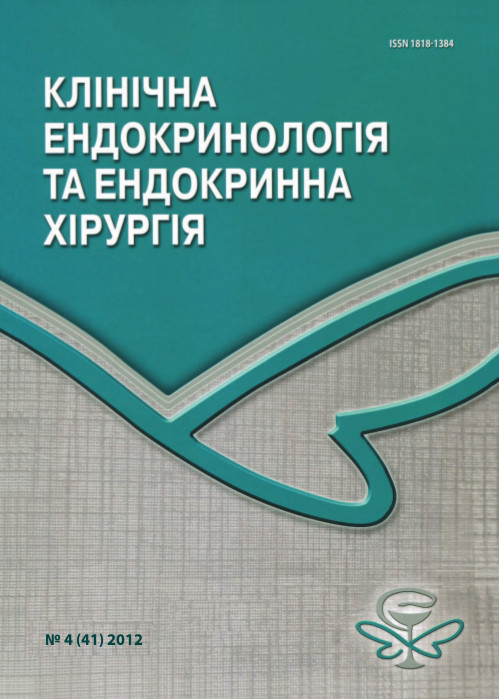Гострі ускладнення цукрового діабету у дітей, які отримують помпову інсулінотерапію
DOI:
https://doi.org/10.24026/1818-1384.4(41).2012.86119Ключові слова:
diabetes mellitus, acute diabetes complications, continuous subcutaneous insulin infusion, multiply daily insulin injectionsАнотація
We investigated the influence of different types of insulinotherapy on development of acute diabetes complications in children. Were examined 2 groups of children with diabetes mellitus (DM), which were treated by continuous subcutaneous insulin infusion (CSII) and multiple daily insulin injections (MDII), in which we studied the frequency of acute complications, daily dose of insulin, glycemic control. The frequency of severe acute complications in group CSII considerably decreased with a significant reduction for severe hypoglycemia already on the second year of treatment and for diabetic ketoacidosis (DKA) – on the first. In a MDII group significant dynamics of frequency of acute complications did not occur. In children who received CSII, the level of HbA1c tended to decrease and significantly decreased about 12 month of treatment. Children who were treated by MDII, HbA1c levels did not change significantly despite the increase of the frequency of use of these children insulin analogues short and long action and significant increasing insulin daily dose on the 2nd and 3rd years of treatment.Посилання
Sulli N. Long-term benefits of continuous subcutaneous insulin infusion in children with type 1 diabetes: a 4-year follow-up / N. Sulli, B. Shashaj // Diabet. Med. – 2006. – №23. – P. 900-906. https://doi.org/10.1111/j.1464-5491.2006.01935.x
Continuous subcutaneous insulin infusion in children with type 1 diabetes / W. Tamborlane, K. Sikes, A. Steffen [et al.] // Diabetes Res. Clin. Pract. – 2006. – №74. – P. 112-115. https://doi.org/10.1016/s0168-8227(06)70011-0
Garcia-Garcia E. Intensive insulin treatment in the first four years of type 1 diabetes in children / E. Garcia-Garcia, R. Galera, P. Aguilera // Pediatric Diabetes. – 2007. – №8(7). – P. 45. https://doi.org/10.1111/j.1399-5448.2007.00292.x
Continuous subcutaneous insulin infusion therapy in children and adolescents with diabetes mellitus type 1: a systematic review / T. Gratzer, K. Jeitler, A. Berghold [ et al.] // Pediatric Diabetes. – 2007. – №8(7). – P. 45.
Effect and safety of subcutaneous insulin infusion in patient with juvenile-onset type 1 diabetes-indications for pump therapy / J. Suzuki, H. Saitoh, S. Morimoto [et al.] // Pediatric Diabetes. – 2007. – №8(7). – P. 47. https://doi.org/10.1111/j.1399-5448.2007.00292.x
King B. In children with diabetes under 5 years old CS2 gives significantly better glycemic control than conventional insulin regimes without side effects such as hypoglycameia / B. King, P. Crock, D. Anderson // Pediatric Diabetes. – 2007. – №8(7). – P. 47. https://doi.org/10.1111/j.1399-5448.2007.00292.x
Beaufort C. Intensive insulin management – An attitude not a regimen: The Hvidoere study group for childhood diabetes: center differences study / C. Beaufort, C. Skinner, P. Swift // Hormone Research. – 2008. – №70(1). – P. 202. https://doi.org/10.1159/000157533
Continuous subcutaneous insulin infusion versus multiple daily insulin injections in patients with diabetes mellitus: systematic review and meta-analysis / K. Jeitler, K. Horvath, A. Berghold [et al.] // Diabetologia. – 2008. – №51(6). – P. 941-951. https://doi.org/10.1007/s00125-008-0974-3
Sulli N. Continuous subcutaneous insulin infusion in children and adolescents with diabetes mellitus: decreased HbA1c with low risk of hypoglycaemia / N. Sulli, B. Shashaj // J. Pediatr. Endocrinol. Metab. – 2003. – №16(3). – P. 393-399. https://doi.org/10.1515/jpem.2003.16.3.393
Insulin Pump Therapy in Youth with Type 1 Diabetes: A Retrospective Paired Study / R. Nimri, N. Weintrob, H. Benzaquen [et al.] // Pediatrics. – 2006. – Vol. 117. – №6. – P. 2126-2131. https://doi.org/10.1542/peds.2005-2621
##submission.downloads##
Опубліковано
Як цитувати
Номер
Розділ
Ліцензія

Ця робота ліцензується відповідно до Creative Commons Attribution-NonCommercial 4.0 International License.





